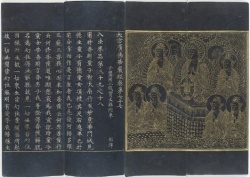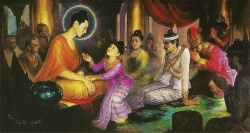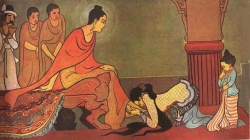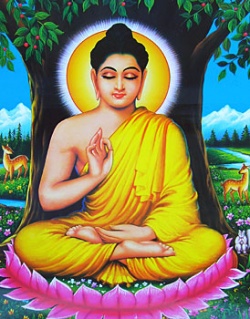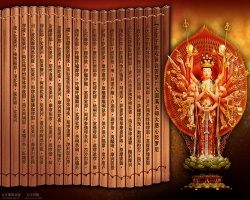Buddhist Calligraphy in Ancient China by Chunyang Zhou
There seems to be no ancient civilization that put Calligraphy on a so remarkable position like the Chinese. And there seems to be no religion that had so profound effects on old Chinese culture like Buddhism. Not surprisingly, the Buddhist Calligraphy presents a magnificent spectacle of Chinese arts. On the other hand, Calligraphy has become a very effective method of Buddhist practice. It was widely loved by Buddhists during all the long history of Chinese Buddhism until today. Here, we must make a difference between the two phenomena —“Buddhist Calligraphy” and “Calligraphy of Buddhists”. The former refers to the lettering art that draws subjects from Buddhist literature. The artists involved in this art include not only Buddhists, but also secular intellectuals. The latter does not necessarily present words from Buddhism. The Buddhists have also created calligraphic works on secular texts. In today’s presentation,only the “Buddhist Calligraphy” falls within the scope of my talk.
1 Relationship between Buddhism and Calligraphy
The writing work was already encouraged in Indian Buddhism. Not only the monks and the nuns but also the layman Buddhists are required to hand-write copies of Buddhist scriptures.[1] Those deeds were seen as filled with great accumulation of merits.[2] But on the other hand, the Buddha is said to have forbidden excessive pursuit of writing skills and defined it as transgression.[3] For example, in Saṃyuktāgama and Yogācārabhūmiśāstra, it was included in the Śilpasthānavidyā (Knowledge of the Practical/Occupational Skills) often possessed by non-Buddhists.[4] In general, calligraphy was treated only as a mechanic technique or convenience like calculation and divination in Indian Buddhist teachings.
The position of calligraphy was heightened greatly in Chinese Buddhism. Though the role of calligraphy was disputed among Buddhists and non-Buddhist intellectuals,[5] Buddhism has contributed tremendously to Chinese calligraphy. Almost half of the famous calligraphic works of ancient China are based on Buddhist subjects or created by Buddhists. The Buddhist spirituality has become one of the most important influences on Chinese calligraphy. In particular, the Zen-School is closely related to the Chinese art.[6] Zen Buddhism emphasizes the intuitive and perceptual above the empirical and logical. This spirit is exactly what the Chinese calligraphic art needed. The “Callig-raphy of Zen” and the “Zen of Calligraphy” are important elements in the calligraphic theories.
2 Forms of Buddhist Calligraphy
The Buddhist Calligraphy was rich in content and diverse in form. By writing material, the old Chinese Buddhist calligraphic works can be classified into Manuscripts, Inscriptions and Engraving Scripts. By author, they can be classified into Calligraphy of Buddhists and Calligraphy of secular artists. By inditing motif, they can be classified into functional calligraphy which occurred in processes of work for practical purposes, and creative calligraphy in which the artists consciously created aesthetic works. By type style, those works can be classified into the Kai script (楷書), Xing script (行書), Cao script (草書) etc.
3 Calligraphy in Manuscripts[7]
The former Chinese Buddhist masters have left us a rich heritage of manuscripts. These manuscripts had not only high historical value but also high artistic value. Many of these are created for Buddhist scripture copying. Before printing technique was invented, all Buddhist scriptures were copied by hand.[8] The copying works typically involve title, main body and Postscript. Space was added between paragraphs. Most of those manuscripts have separating lines that helped to make even spacing. The spaces between character on the same line are usually different.[9]
The works from the Northern dynasties are especially accordant in lettering style. Their style is strongly influenced by Lishu (隶書) which was prospered in Han dynasty. The characters are square or transverse oblong in shape. Various writing techniques like Lüe, Ge and Zhe were used in those manuscripts.[10] They give a person with vivid and active feeling. Nonetheless, their calligraphy was conservative and solemn. Compared with contemporary secular calligraphic works, the Buddhist manuscripts seem to be simple, unsophisticated and elegant. The most characteristic part is the writing of the transverse lines (Heng). The calligraphers made the strokes gradually increase in weight. At the end of the transverse lines, they drew back the tips of Ink-brushes emphatically so that the visual focal point stayed there.[11] Characteristics such as these have made the occurrence of the category “the Style of Sūtra-Writing” (Xiejing Ti 寫 經體).[12]
4 Calligraphy in Inscriptions
In addition to the manuscripts, the inscriptions have become another main carrier of the Buddhist calligraphy. In Northern dynasties, the grottoes art rose in a large amount in China. The enthusiasm has persisted to Tang dynasty. The famous Buddhist temple grottoes such as Yungang (雲岡), Longmen (龍門) and Dunhuang (敦煌) grottoes were constructed mainly during this period. Inscriptions formed an indispensable element of those grottoes. Many of these inscriptions have been seen as model works by later calligraphers. Outstanding examples are the works of “Longmen Ershipin” (龍門二十品).[13] They have a plain, wild, hardy and grand style. Their script is called Weibei (魏碑). In addition to the inscriptions in grottoes, there have been many inscriptions in temples, mountains and stūpas. For instance, the inscription of the Diamond Sūtra in Tai Mountain can be ranked as a masterpiece throughout the ages with its vigorous and forceful style.[14]
5 Calligraphy and Buddhist Practice
Calligraphy was the hobby and skill of a lot of famous Buddhist monks. It seems that the artist activities and Buddhist practice trend to combine each other. It was said that the famous Buddhist calligrapher Huaisu “did not talk about Sūtra, did not speak about Dhyāna; he was full of vitality only when he was creating calligraphy of Grass Script”.[15] Huang Tingjian, the calligrapher of Song dynasty, tried to explain the art with Zen theory: “There are strokes in the characters as there are ’eyes’ in the sentences of Zen masters. Only those who have the ’eyes’ can know it.”[16] Kuang Youwei, a calligrapher of Qing dynasty, also said: “I would say: ’The Dharma of calligraphy is like the Dharma of Buddha. It begins with the discipline; It is improved in meditation and wisdom; It is realized in the origin of Heart; It becomes wonderful through comprehension. If it has reached the peak of perfection, it is also unutterable.”[17] However, the opinions differed among Chinese Buddhists and intellectuals concerning how to explain the relationship between calligraphy and Buddhist Practice. For example, Hanyu challenged the harmony of calligraphy and Buddhism. In his opinion, calligraphy belongs to art, and the art should present earthly life; But the earthly life is seen to be false in Buddhism. therefore, it will be impossible to create calligraphy with Buddhist philosophy. But, anyway, Both the history of Chinese Buddhism without calligraphy and the history of Chinese calligraphy without Buddhism are unthinkable.
Footnotes
- ↑ Hu [2000]: [1].
- ↑ 2See inter alia 增一阿含經T II 125, 550c5 f.: 若有書寫經卷者。繒綵花蓋持供養。此福無量不可 計。以此法寶難遇故。
- ↑ 3See inter alia 十誦律T XXIII 1435, 64c24 f.: 又比丘往語估客子比丘言。汝估客種。用出家受戒 爲。汝應學書算數印相。學知金銀相絲綿繒綵。學坐金肆銀肆客作肆銅肆珠肆。如是種種估客技術 汝應學。輕毀心故。一一語突吉羅。
- ↑ Hu [2000]: [1].
- ↑ Cf. Xiong [2002] 183 f.
- ↑ Cf. Wu [2007].
- ↑ On the calligraphy of manuscripts cf. Gung [2002].
- ↑ Cf. Xu [1997]: 248.
- ↑ Xu [1997]: 253.
- ↑ On the Chinese calligraphic techniques cf. Chiang [1973].
- ↑ Xu [1997]: 253.
- ↑ Neither is this style to be understood only of Buddhist calligraphy. It is also related to certain Confucian and certain Daoist manuscripts but in much smaller numbers. Cf. Gung [2002].
- ↑ “Longmen Ershipin” is a collection of beautiful, originally independent inscriptions from Longmen grottoes. It was often printed for the purpose of learning calligraphy in China. Cf. Dai [2003] 113 f.
- ↑ On this work cf. Cai [2006].
- ↑ See 貫休(832 - 912) “觀懷素草書歌”: 師不譚經不說禪,筋力唯於草書朽。
- ↑ “山谷全集”: 書中有筆。如禅家句中有眼。直須具此眼者。乃能知之。On the relations between calligraphy and Buddhism that are interpreted by Huang cf. He [2006].
- ↑ See “廣藝舟雙楫”:吾謂書法亦犹佛法。始于戒律。精于定慧。証于心源。妙于了悟。Cf. Xiong [2002]: 204.
=
Source
=
- Chong-ming = 蔡崇名Cai. The calligraphic art of the ”diamond sutra inscribed on the tai mountain = 〈泰山經石峪金剛經〉的書法藝術. Universal Gate Buddhist Journal = 普門學報, (35):125 – 140, 9 2006. 4
- Yee Chiang. Chinese calligraphy: an introduction to its aesthetic and technique. Harvard Univ Pr, 1973. 4
- Yiguang = 戴一光Dai. 书法文化之旅. 上海书画出版社, 2003. ISBN 9787806727089. 4
- Peng-cheng = 龔鵬程Gung. A study of the buddhist and dao scripture based on ancient calligraphy = 佛道經典書帖考. Universal Gate Buddhist Journal = 普門學報, (10): 143 – 176, 7 2002. 4
- Jin-song = 何勁松He. Huang tin-jian’s calligraphic art and its ideological basis of ch’an buddhism = 論黃庭堅書法思想的禪學基礎. Universal Gate Buddhist Journal = 普門學報, pages 81–124, 2006. 4
- You-neng = 吳有能Wu. The approach of inner subjectivity in the art of chinese calligraphy: with special reference to the ch’an buddhism =中國書道藝術的內在主體性進路– 以禪宗精神為中心. Universal Gate Buddhist Journal = 普門學報, (42): 1 – 31, 11 2007. 4
- Bingming = 熊秉明Xiong. 中国书法理论体系. 天津教育出版社, 2002. ISBN 9787530934258. 4
- Liming = 徐利明Xu. 中國書法風格史. 中国书学丛书. 河南美術出版社, 1997. 4
Source
Author: Chunyang Zhou
